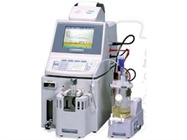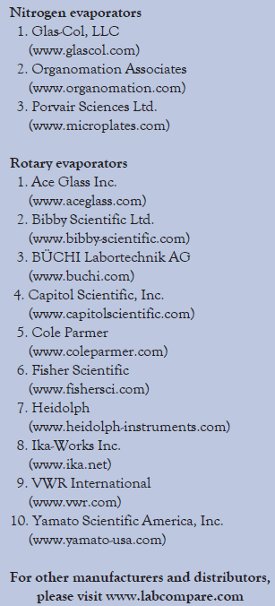Featured Article

Please check out our Rotory Evaporators or Nitrogen Evaporators sections for more information or to find manufacturers that sell these products.
Evaporation systems have many industrial, medical, and basic science applications (Table 1). Selecting the right instrument among the wide range of manufacturers and models can be a challenge. As with any laboratory equipment, this decision is application-based and can be better understood by taking a close look at your specific separation, cleaning, or concentration needs. This article aims to help in the selection process by giving a background on evaporation technology, clearly defining evaporator specifications, and discussing key purchasing considerations such as product validation. Though there are many models with overlapping features and applications, this article will focus primarily on rotary and nitrogen evaporator platforms.
Evaporation technology: from the research laboratory to the chemical, pharmaceutical, food, and petrochemical industries
Evaporation is a common and important step in many research and development applications. The concentration of solutions by distilling the solvent and leaving behind a higher-boiling or solid residue is a necessary step in organic synthesis and extracting inorganic pollutants. Evaporator use outside the research laboratory spans the chemical, pharmaceutical, petrochemical, and food industries. Though the principles behind laboratory distillation apparatus have hardly changed since the time of ancient alchemy, understanding the commercially available evaporators can make selecting the right evaporator for a particular application easier.
Table 1 – Selected nitrogen and rotary evaporator manufacturers and distributors

The rotary evaporator is divided into four primary parts: 1) the heating bath and rotating evaporation flask, 2) the separation elbow, 3) the condensation shaft, and 4) the collection vessel. The rate of evaporation is controlled by the heating bath temperature, the size of the rotating flask, the vacuum, and the speed of rotation. Rotating the evaporation flask creates a thin film of solvent spread across the surface of the glass. By creating more surface area, the rotating solvent evaporates more quickly. Rotation also ensures the homogenous mixing of sample and prevents overheating inside the flask. A vacuum can be used to lower the boiling temperature, thereby raising the efficiency of the distillation. The solvent vapor flows into the condensation shaft and transfers its thermal energy to the cooling medium, causing it to condense. The condensate solvent flows to the collection vessel.
Compared to a static apparatus, the vacuum rotary evaporator can carry out singlestage distillations quickly and gently. The capacity of a rotary distillation is generally about four times greater than a conventional static distillation.
Nitrogen evaporation, or blowdown, removes the solvent by blowing nitrogen over the liquid surface, and is generally used for the evaporation of smaller solvent volumes. Nitrogen blowdown is applicable only when the solute has a low vapor pressure. Evaporation is accelerated by decreasing the partial vapor pressure of the solvent at the liquid surface. Nitrogen evaporators use small gas nozzles to continually force off the layer of air, at the solution surface, which is saturated with vapor. This prohibits molecules that enter the vapor state from returning to the liquid, thereby increasing evaporation rates.
Nitrogen blowdown is very useful for small sample volumes (<50 mL). Larger volumes will take a very long time to blow down, and semivolatile compounds may be lost as a result. Some nitrogen evaporators may include features that force any stray sample down the sidewalls of the sample vessel, minimizing loss. Additionally, most nitrogen evaporators handle multiple samples ranging from 2 to 96 vial positions.
Common applications for nitrogen evaporation include environmental organic analysis, organic analytical chemistry, petroleum analysis, food chemistry, forensic organic analysis, and organic geochemistry.
Hybrid evaporators
Hybrid evaporators incorporate the increased surface area techniques found in rotary models with nitrogen blowdown. Shaking motors can be used to create a liquid vortex in the sample, forcing the liquid to climb the sidewall, and exposing more surface area to the nitrogen nozzles. Glas-Col (Terre Haute, IN) Analytical evaporators provide a highly tunable and efficient method of solvent evaporation by combining a) individual gas nozzles (needles) over each sample deliver even gas, b) heat input to both the sample bottom and the incoming nitrogen, and c) a pulsing feature that forces a film of solvent to be thrown against the sidewall.
These three evaporator types are in no way meant to be a complete catalogue of the formats commercially available. Additionally, there are Karl Fischer (KF) evaporators, used for sample preparation in KF titration by means of azeotropic distillation; solid evaporators, used for solid samples that are not soluble in Karl Fischer reagents or contain interfering substances; and Soxhlet extraction, which is generally used to extract lipids from a solid material.
Key purchasing considerations for evaporators
To aid buyers in understanding their evaporation needs and the limitations of specific evaporation models, common evaporator specifications and terms are defined below along with their respective implications.
Bumping: When there are no air bubbles to act as nucleations and the liquid is not moved by some additional means, it cannot evaporate and will overheat. The convection current is unable to distribute the input heat quickly enough, and evaporation begins abruptly when the overheated liquid finally reaches the surface. This is called bumping. Large escaping vapor bubbles can carry over a large part of the liquid and lead to large losses. Bumping can be avoided by stirring or shaking the liquid, or by using boiling stones.
Number of samples and sample size (nitrogen evaporators): Distilling multiple samples simultaneously can dramatically affect work flow in the laboratory, as well as increase uniformity within multiple sample evaporations. Nitrogen evaporator models can accommodate 2-, 8-, 12-, 24-, 28-, 48-, and 96-vial positions ranging many standard vial sizes commonly used in the lab (e.g., 2 mL–40 mL).
Flow rate (psi) (nitrogen evaporators): Many multiport nitrogen evaporators allow individual gas port adjustment. Gas ports can be shut down completely if necessary. Flow rate should be tunable, equal across all ports, and be even from start to finish (i.e., no nitrogen outbursts).
Rotation speed range (rpm) (rotary evaporators): Forced convection takes place when layers of the liquid are mixed mechanically by stirring or rotating the evaporation flask; hence a homogeneous temperature is maintained throughout the distillation. The rotation speed should maximize turbulence inside the flask. The higher the rate of rotation, the higher the rate of distillation up to the point when the fluid is pressed against the flask wall by centrifugal force and will co-rotate, thus decreasing turbulence within.
Vacuum (mm Hg): The higher the ambient pressure, the higher the temperature of ebullition. The reverse is also true, and by creating a vacuum, higher-boiling substances can be distilled at a lower temperature. This can be critical when you need to prevent damage to temperature-sensitive substances.
Additional purchasing considerations include the reputation of the manufacturer itself. Nonproduct issues must be evaluated in addition to technical needs. These include the industry knowledge and depth of experience of the company.
Evaporator validation
Each evaporator should be validated prior to use to ensure its ability to achieve the performance outlined by the manufacturer. A demonstration from the manufacturer or distributor may be possible. Also, you can develop simple validation experiments based on published evaporation rates, paying careful attention to prescribed experimental conditions (i.e., temperatures, rotation speeds, and vacuums). You may also want to consult with other laboratories that currently own the model of interest or have similar evaporation needs.
Solvent recovery
Salvaging solvents is an important component of the evaporation process. Maximizing solvent recovery rates involves optimizing solvent- and product-specific temperature and pressure conditions, correct choice of equipment, and proper understanding of the physical processes involved in distillation.
T. Keith Brock, BS, is a Contributing Writer, American Laboratory/Labcompare; e-mail: biobrock@ gmail.com.